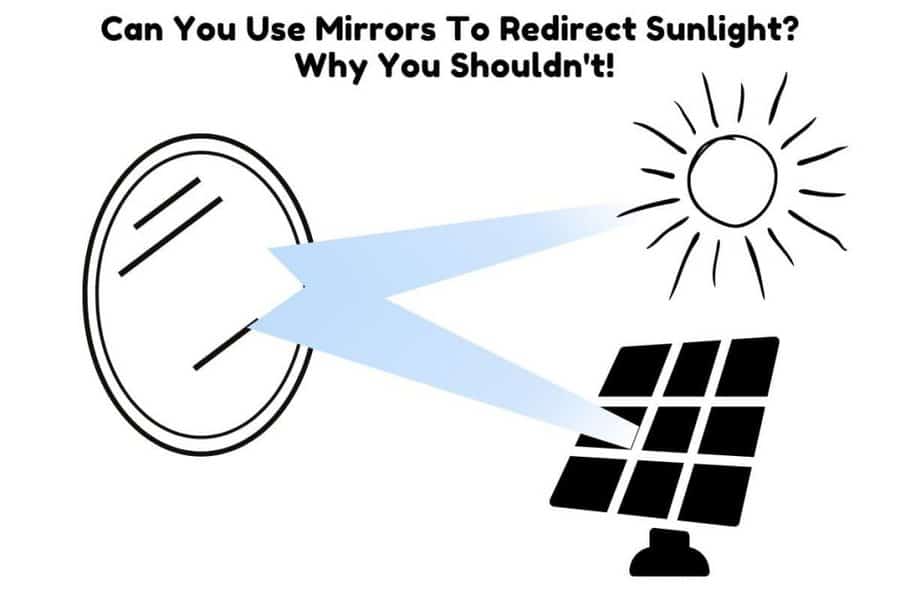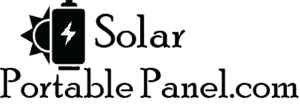A square foot of solar panel produces enough electricity to cover half the needs of an average size home. But what if you wanted to get more out of that solar panel? Can you boost the output of a solar panel without increasing its size?
Mirrors can be used to provide a solar panel with more light. Increasing the incidence of light on a solar panel will boost its energy production.
How does that happen and how much more energy will that yield? In this article, we explore how you can increase the output of a solar panel with mirrors. We also look at a few other tips and tricks you can use to improve solar energy production as well as what effect using a solar panel through glass has.

Can I Use A Mirror To Reflect Sunlight For Solar Panels?
Reflecting sunlight onto solar panels will increase the amount of available sunlight that can be absorbed and converted into energy. This will boost the solar panel output by as much as 30%.
On a side note! If you’re in need of a reliable and high-performance portable solar panel, We strongly recommend the Jackery SolarSaga 100W Portable Solar Panel (Amazon Link).
With a high conversion efficiency and foldable design, this solar panel is easy to transport and set up, making it perfect for outdoor activities like camping, hiking, and RV trips.

The US solar cell technology used in this panel ensures that you get the most efficient and reliable solar charging possible.
There is also a 60W option that is more affordable (Amazon Link)
Light is the principal factor in how a solar panel produces electricity. Exposing a solar panel to light sets off a molecular reaction. Particles of energy or photons charge the electrons found within the two layers of a solar panel.
Once these electrons are charged, they move between the layers creating a flow of current that powers your appliances or charges your batteries. That in simple terms is the photovoltaic effect.
Reflecting a mirror onto a solar panel amplifies the photovoltaic effect. When you reflect more light onto the solar panel you allow it to capture more light. Not all of the light is absorbed by a solar panel.
An untreated solar panel absorbs only 67.4 percent of sunlight. That means a third of the light is lost either through reflection or refraction. That’s why all solar panels are treated by texturing and with an anti-reflective coating.
Texturing is when the surface of a silicon cell in a solar panel is roughened to increase the chances of light reflecting onto the silicon surface instead of into the air.
An anti-reflective coating is a material applied to a silicon cell to reduce the reflection of light from a solar panel. The blue or black color you see on a solar panel is the layer of anti-reflective coating. Source
In combination, texturing and anti-reflective coating bring the absorption of a solar panel up to 90 percent. There is still some light not being captured by the solar panel.
Using mirrors, you can send more light to the solar panel which can improve the output. Several scientific studies demonstrate how using mirror reflectors can increase the yield of a solar panel by between 20 to 30 percent. Source
This works especially well on days when the sun is not shining as brightly due to cloud cover or because the sun is lower in the sky as in winter.
A simple and cheap experiment you can perform to test out the effectiveness of using a reflection to boost production is to use a simple reflector made from tin foil.
Wrap foil around cardboard or wooden backboard then place your solar panel where it will receive both direct sunlight and reflected sunlight. One experiment using this method resulted in a boost in solar energy yield of 75 percent.
Why Not Use Mirrors With Solar Panels?
The biggest constraint with using mirrors with solar panels is that not only do the mirrors increase the incidence of light, but they also increase the temperature. Any increase in temperature on a solar panel will reduce its efficiency.
Solar panels are tested under standard test conditions (STCs) to determine their output. In terms of the STCs a solar panel is passed if it produces a certain amount of energy when:
- It is exposed to more than 1000 watts of direct sunlight.
- At a temperature of 25 degrees Celsius.
How heat affects solar panels
Solar panels have a temperature coefficient. This is a measure of the decrease in output in a solar panel because of a temperature rise. In other words, solar panel efficiency has an inverse relationship with temperature. The higher the temperature the lower the efficiency.
Shining more light on a solar panel creates hotspots and increases the overall temperature of the solar panel. The temperature rise is typically small, averaging less than 5%. Heat is one of the reasons why mirrors are not used with solar panels. It is not the only reason, however.
Mirrors introduce an additional layer of complexity to solar panel design. The sun moves through the sky throughout the day. The mirrors used to direct more sunlight can cause shading on the solar panels as the sun shifts its position. This introduces a need to adjust the positioning of the mirrors to track the sun’s movement.
Between the increased heat and the need to constantly adjust the positioning of the mirrors, the added complexity is not worth it at the scale of a small residential solar system. This isn’t the case with larger solar farms, however.
Are Mirrors Used To Produce Solar Energy?
Mirrors are used on commercial utility-scale solar plants. Concentrating solar thermal power (CSP) technology uses mirrors to reflect sunlight onto a receiver. Fluid in the receiver is heated to produce thermal energy which powers a turbine or engine to produce electricity.
CSPs are typically large commercial farms. There are several types of CSP technology in use. The most common are power towers and linear systems.
In a power tower system, mirrors are arranged around a cylindrical tower to reflect sunlight onto the tower. In a linear system, rows of mirrors reflect sunlight onto parallel tubes directly over the mirrors. Source
Solar farms that use CSPs are huge projects that produce tens to hundreds of megawatts. A major drawback of CSPs is that they take up an enormous amount of land space. CSP plants take up to 10 acres of land for every megawatt produced.
Can A Solar Panel Work Through A Glass Window?
Solar panels can work through glass. The disadvantage to using solar panels through glass is the efficiency of the solar panel diminishes due to there being less light being absorbed. Glass reflects and absorbs up to 8 percent of the light it is exposed to.
For more on this, check out our post Do Solar Panels Work Behind/Through Glass/Windows & Indoors?
